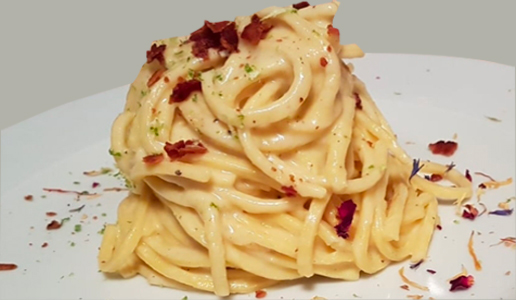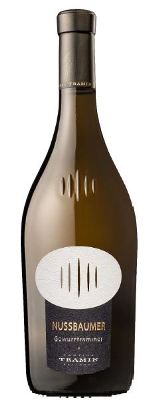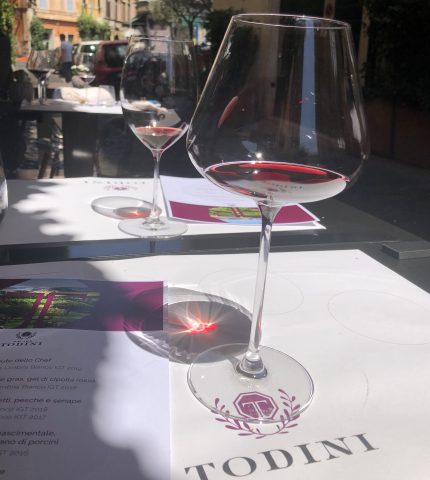Tonnarelli with a creamy cacio e pepe sauce topped with bacon crumbs and lime peel

This particular version of cacao e pepe (cheese and pepper) pasta has a strong flavor with a hint of freshness from the lime. We pair it with a bold and aromatic white wine: Alto Adige Gewürztraminer Nussbaumer Cantina Termeno (Kellerei Tramin).
Ingredients for 4 people:
400g fresh tonnarelli pasta, 6 thin slices of bacon, 1 medium-size yellow potato, 220g grated pecorino Romano cheese, 100g cold butter, 1 frozen lime and freshly ground pepper as desired.
Directions:
Place the bacon slices on baking paper and toast them in the oven at 180°C. Crumble when done.
Slice the potato thinly and put the slices in a pan barely covering them with cold water. Boil the slices until they disintegrate (2-3 minutes).
Put the potatoes, still warm, in a mixer with the cold butter that has been cut into pieces, the grated pecorino and the ground pepper and blend everything together to make a sauce.
Boil the tonnarelli in abundant salted water. Heat the sauce in a broad pan, add in the cooked pasta and mix together, if necessary adding some of the pasta water to make sure it stays creamy.
Serve the cacao e pepe on warmed plates and top with the bacon crumbs and grated lime peel.

Alto Adige Gewürztraminer Nussbaumer 2016 Cantina Termeno/Kellerei Tramin
Bright straw yellow color. Impressive aromatic bouquet: exotic fruits, spices, white flowers. Powerful taste but elegant and juicy at the same time. Long and varied finish.
Production area: Tramin - the German name of Termeno - is considered to be the cradle of Gewürztraminer. The vineyards are located at 350-550 mt a.s.l. and the soil is an ideal combination of a calciferous gravel with loam on porphyry bedrock, a tightly woven fabric of nutrients that gives the grapes a sense of complexity.
Grape variety: Gewürztraminer with a yield of 45 hl/hectare.
Wine-making: at harvest (end of September – end of October) the grapes were delivered in small bins and gently pressed after a short period of maceration. Fermentation takes place slowly, at a controlled temperature of 18°C in small stainless steel tanks. Must clarification takes place through natural sedimentation of the particles.Maturation took place in small steel tanks with constant contact with the lees until the end of August. After bottling, the wine matured in the bottle for another 3 months. The total maturation period is thus at least 14 months.
Alcoholic content: 14.9 % vol.
Potential aging: 7 to 15 years.
Serving temperature: 12-14°C.
Suggested food pairing: pairs well with antipasto of fish or smoked foods, ripe soft cheese, white meat, swordfish or tuna; ideal with shellfish and seafood, spectacular accompaniment to spicy oriental cuisine and creative spicy/aromatic creations such as combinations with mushrooms, Swiss chard, fennel, avocado, savoy cabbage, galangal, ginger, oranges, apricots, jams and fresh herbs like tarragon, rosemary, dill, thyme, bay laurel, chervil, saffron, mint or lemongrass which offer a wild interplay of aromas.

 Italiano
Italiano








